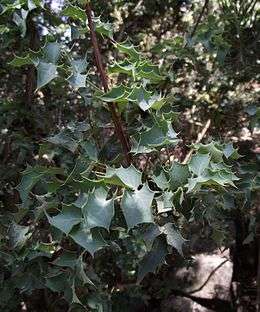Berberis higginsiae
| Berberis higginsiae | |
|---|---|
 | |
| Scientific classification | |
| Kingdom: | Plantae |
| (unranked): | Angiosperms |
| (unranked): | Eudicots |
| Order: | Ranunculales |
| Family: | Berberidaceae |
| Genus: | Berberis |
| Species: | B. higginsiae |
| Binomial name | |
| Berberis higginsiae Munz | |
| Synonyms[1] | |
| |
Berberis higginsiae is a shrub found only in a small region south and east of San Diego in southern California and northern Baja California. It grows in chaparral and woodland areas at elevations of 800–1,200 m (2,600–3,900 ft).[1]
Berberis higginsiae is evergreen, with thick, stiff compound leaves. It sometimes reaches a height of up to 3 m (9.8 ft). It is similar to B. fremontii and B. haematocarpa but with narrower leaflets and yellowish-red berries.[1][2]
The compound leaves place this species in the group sometimes segregated as the genus Mahonia.[1][3][4][5]
References
- 1 2 3 4 Flora of North America v 3
- ↑ Munz, Philip Alexander. Aliso 4(1): 91–92. 1958.
- ↑ Loconte, H., & J. R. Estes. 1989. Phylogenetic systematics of Berberidaceae and Ranunculales (Magnoliidae). Systematic Botany 14:565-579.
- ↑ Marroquín, Jorge S., & Joseph E. Laferrière. 1997. Transfer of specific and infraspecific taxa from Mahonia to Berberis. Journal of the Arizona-Nevada Academy of Science 30(1):53-55.
- ↑ Laferrière, Joseph E. 1997. Transfer of specific and infraspecific taxa from Mahonia to Berberis. Bot. Zhurn. 82(9):96-99.
This article is issued from Wikipedia - version of the 10/31/2016. The text is available under the Creative Commons Attribution/Share Alike but additional terms may apply for the media files.